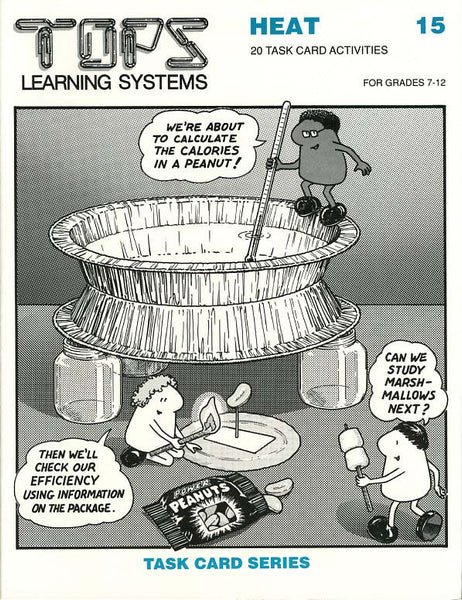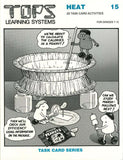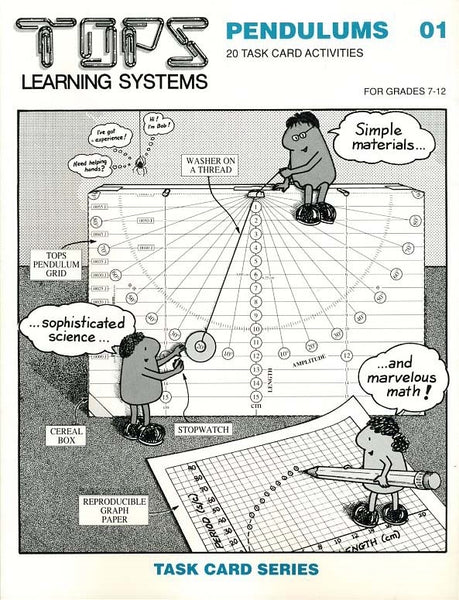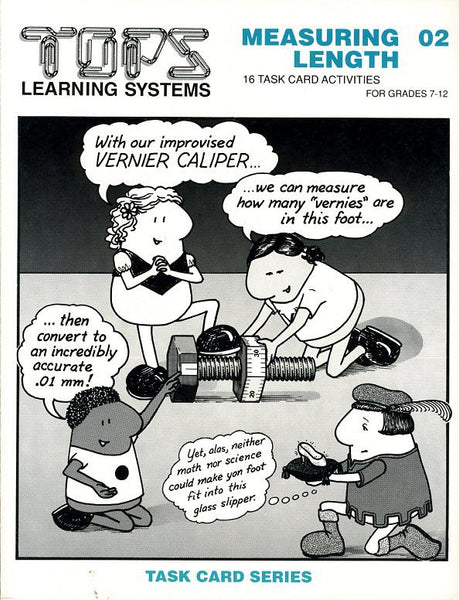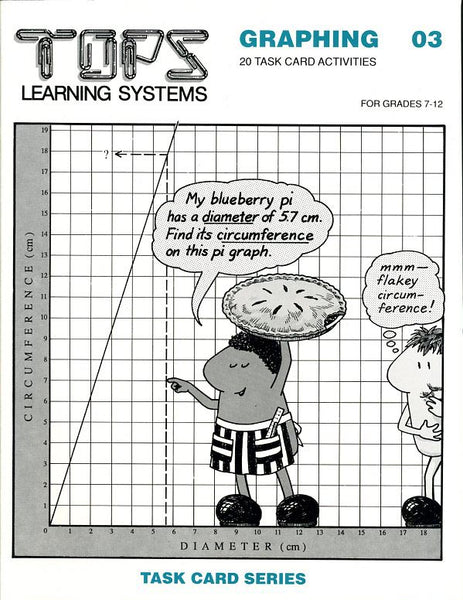#15 Heat (grades 8-12)
Regular price $20.95
Click here for a complete list of materials and convenient shopping.
aluminum, copper and steel wire with equal diameters, wire cutters, candles with drip catchers, books of matches, microscope slides, scissors, thin, recyclable, aluminum pie tins, ice cubes, sandwich bags, masking tape, blue food coloring source of hot and cold tap water gas burners (alcohol lamps), needed in one lab to heat metal red hot, pint jars, baby food jars, index cards, spool of thread, test tubes, steel wool, paper clips, clothespins, toothpicks, tin can tops, about 15 ounce size, tin cans, about 15 ounce size, pennies, aluminum foil, clear tape, laboratory thermometers, sheets black paper, teapot of hot water, corks to fit test tubes (lumps of oil-based clay), jar of sand, graduated cylinders, 100 mL, styrofoam cups, milk jugs, graduated cylinders, 1000 mL capacity (substitute quart or liter jars with 500 mL and 1000 mL levels clearly marked), calculators, washers, bolts or other small iron objects, gram balances, small container of flour, bag roasted peanuts, straight pins
- Lesson 1: To trace heat flow through a wire. To understand how atoms in the wire interact to conduct heat.
- Lesson 2: To discover that some metals conduct heat more rapidly than others. To understand how electrons interact in wire to conduct heat.
- Lesson 3: To contrast the heat conduction properties of a conductor with an insulator.
- Lesson 4: To observe the heat flows from higher-temperature objects to lower-temperature objects. To recognize that air is a very good insulator.
- Lesson 5: To observe that hot water is lighter (less dense) than cold water. To understand why heated fluids convect upward.
- Lesson 6: To build a simple windmill that will rotate in the convection currents generated by a burning candle.
- Lesson 7: To appreciate that water is a good convector of heat, but a poor conductor.
- Lesson 8: To discover that paper in direct contact with a candle flame won't burn, as long as its heat is conducted away.
- Lesson 9: To understand that heat energy also travels like light, as an electromagnetic wave. To distinguish between conduction, convection and radiation.
- Lesson 10: To observe that radiated heat energy tends to be absorbed by a dull black surface, and reflected by a shiny metallic or white surface.
- Lesson 11: To test black, white and shiny metallic surfaces as emitters of heat radiation. To distinguish between the three processes of heat transfer.
- Lesson 12: To test black, white and shiny metallic surfaces as absorbers of heat radiation.
- Lesson 13: To construct a functioning greenhouse. To use it as a model for explaining how carbon dioxide gas in our atmosphere acts to warm the Earth.
- Lesson 14: To compare cooling curves for glass and metal containers.
- Lesson 15: To define and use calories as a unit of heat energy. To distinguish between temperature and heat.
- Lesson 16: To discover that the amount of heat given off by hot water equals the amount of heat absorbed by cold water.
- Lesson 17: To discover that heat lost equals heat gained for unequal volumes of water. To confirm that kinetic energy is conserved.
- Lesson 18: To compare the capacities of water, sand and iron to absorb heat.
- Lesson 19: To compute heat capacities and specific heats for water, sand and iron. To understand how these results influence weather.
- Lesson 20: To experimentally determine the heat content of a peanut.
We encourage improvisation - it's one of the main goals of our hands-on approach! You and your students might invent a simpler, sturdier or more accurate system; might ask a better question; might design a better extension. Hooray for ingenuity! When this occurs, we'd love to hear about it and share it with other educators.
TEACHING Standards
These 20 Task Cards promote excellence in science teaching by these NSES criteria:Teachers of science...
A: ...plan an inquiry-based science program. (p. 30)
B: ...guide and facilitate learning. (p. 32)
C: ...engage in ongoing assessment of their teaching and of student learning. (p. 37)
D: ...design and manage learning environments that provide students with the time, space, and resources needed for learning science. (p. 43)
CONTENT Standards
These 20 Task Cards contain fundamental content as defined by these NSES guidelines (p. 109).• Represent a central event or phenomenon in the natural world.
• Represent a central scientific idea and organizing principle.
• Have rich explanatory power.
• Guide fruitful investigations.
• Apply to situations and contexts common to everyday experiences.
• Can be linked to meaningful learning experiences.
• Are developmentally appropriate for students at the grade level specified.
Unifying Concepts and Processes
NSES Framework: Systems, order, and organization • Evidence, models and explanation • Constancy, change, and measurement • Form and functionCore Concepts/Processes: Radiating heat is a form of electromagnetic radiation, similar to radio waves, light, and gamma rays. • Kinetic energy transfers between bodies but remains conserved. • Temperature is a measure of average kinetic energy, while heat is a measure of total kinetic energy.
Science as Inquiry (content standard A)
NSES Framework: Identify questions that can be answered through scientific investigations. • Design and conduct a scientific investigation. • Use appropriate tools and techniques to gather, analyze, and interpret data. • Develop descriptions, explanations, predictions, and models using evidence. • Think critically and logically to connect evidence and explanations. • Recognize and analyze alternative explanations and predictions. • Communicate scientific procedures and explanations. • Use mathematics in all aspects of scientific inquiry.Core Inquiries: Inquire into heat transfer by conduction, convection and radiation. • Count heat calories with a thermometer. • Measure heat capacity.
Physical Science (content standard B)
NSES Framework:Heat • Properties and changes of properties in matter • Transfer of energy • Conservation of energy • Interactions of energy and matterCore Content:Conduction • Convection • Radiation • Absorption • Reflection • Insulators and conductors • Cooling curves • Temperature in degrees Celsius • Heat in calories
Science in Personal and Social Perspectives (content standard F)
NSES Framework: Changes in environments • Natural and human-induced hazardsCore Content: Greenhouse gases (carbon dioxide in particular), is creating rapid global climate change.

